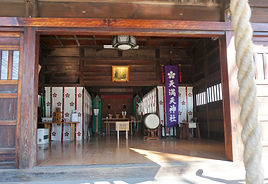普通の外にいくつかの著名な品質を持っている、と畏敬の念を起こさせるあるいかなるビーイングは、カミと呼ばれています。
Kanagawa-ken, Kawasaki-shi, Saiwai-ku, Higashi-furuichiba 83
神奈川県川崎市幸区東古市場83
天満天神社
Tenmanten Jinja
February 14, 2019
Nearest station
Kashima
JR Nanbu Line
History
What we know of the early history of this shrine comes from an an inscription on original torii. This was destroyed during the Great Edo Earthquake of 1855, but according to the inscription the shrine was founded in the early sixteenth century through the generosity of twenty or so farming families living in the Furuichiba area. At that time the shrine was situated upstream of what is now the Tamagawa River Bridge (多摩川大橋) on land belonging to the Tokugawa Bakufu. With the introduction of the prefectural system following the Meiji Restoration the shrine's location became Furuichiba in Tōkyō's Ebara-gun.

Enshrined Kami:
Main
(Note: numbers in parentheses after kami names
refer to position in How Many Kami table)
From Merged Shrines
None
In-ground Shrines:
None
Annual Festival: August 25


In April 1912 it was moved to the then Miyuki-mura (御幸村) in Kanagawa-ken. The new site, however, was subject to flooding. necessitating a lot of work on the shrine's buildings and it was not until October 1915 that the Sengūsai ceremony was formally held.
Just five years after this, December 1920 to be precise. large scale works on the Tama River led to another relocation, this time into what are now the grounds of the Toshiba Komukai factory. Come January 1943 though, the exigencies of war spurred the expansion of the factory and the shrine was moved yet again, this time to its current location, slightly to the north of the factory.
Given these frequent moves the shrine buildings were close to dilapidation and in 1962 the main hall and the shrine office were rebuilt with the help of local residents. Along with this, the torii, which had been badly damaged in the Great Kantō Earthquake of 1923, was restored to its original state and is preserved in the earlier shrine site inside the Toshiba factory grounds.
Description
About 20 min on foot from Kashima Station. Visually not that interesting, although the two camphor trees flanking the torii are said to be spectacular in full bloom. The two koma-inu in front of the main hall date to 1923.
(Click on images to expand them)












